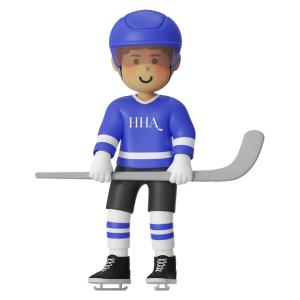
Whether you are a player or a parent, navigating the hockey ladder as you get to the junior hockey stage can get a bit confusing.
In this in-depth guide, our team will help break down all the nuances for you so that by the end of this guide, you’ll have a better indication on the best path for you (or your player).
In this guide, we’ll cover:
•What is Junior Hockey
•Junior Hockey Leagues/Levels
•Junior Hockey in US
•Junior Hockey in Canada
•What Makes A Junior League Good?
•How to best decide the best path for you
Let’s buckle that chip strap and hop on the ice…
We’ll get started in this insider’s guide by giving a high level overview of what junior hockey is.
If you’re reading this guide, that’s probably what you’re after…to either play at the next level yourself (or help your player do so).
Some of you reading this likely already know a bit on the info we’ll share below in Chapter 1, but it makes for a solid refresher and will add value to your understanding as we move a bit further into this guide.
Let’s get into it…
In general, junior hockey is considered an amateur level of hockey. This is because players here aren’t deemed professional yet.
There are several exceptions to this in that the three major junior hockey leagues (OHL, WHL, QMJHL) aren’t viewed as amateur, but it’s still considered juniors.
Slightly confusing but no need to fret….we’ll touch on this more momentarily.
Junior hockey is played primarily by players between the ages of 16 and 20.
A very rare number of players can technically receive exceptional player status which allows them to start juniors a season early at age 15 (example: Connor McDavid in 2012- Erie Otters). This is extremely rare though.
A small number of junior leagues in North America also allow teams on the higher end to roster 21-year-olds, but it’s not overly common across the majority of junior leagues. You’ll see this most often at the Junior C level in Canada.
In terms of hierarchy, junior ice hockey in the US and Canada serves as a developmental step on the hockey path for aspiring players.
It sits between youth hockey and the higher levels of hockey which may include college hockey (NCAA, USports, ACHA), major junior, and professional leagues both in North America and Europe.
It’s very important to understand that in the hockey world in N America, the majority of players aiming to play college/pro play junior hockey at some point.
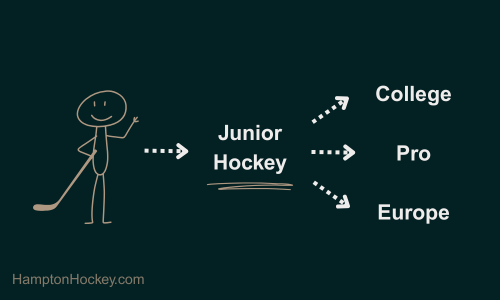
For some parents or players reading this, this may seem foreign as with most other sports, athletes graduate high school their senior years and move directly to an NCAA, USports, etc program as freshman the following fall.
In the hockey world, you’ll often see players playing junior in high school, some continuing after (gap years), and then finally going the college or pro route following this.
If you play high level prep school or HS hockey (say in MN), you may be able to make the jump right to NCAA hockey, but even in many of these instances for commitments, they’ll often spend a season or 2 in juniors prior to entering college.
The far majority of players aiming to keep playing hockey after youth hockey will play junior hockey at some point in their journeys.
The stats back this up.
Most collegiate hockey players in North America are between the ages of 20-24…many are already 19-20 years old when they enter as freshman.
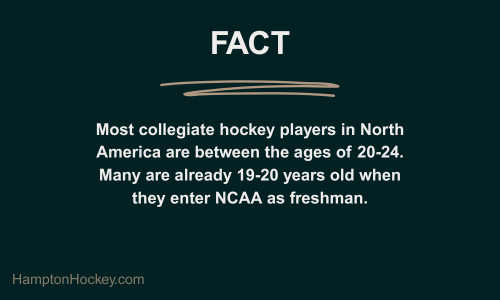
The added year (or a few) of gained experience, skill, and maturity on/off the ice will allow you to greatly strengthen your game to move to the level.
Not always, but coaches across college and pro levels are generally much more attracted to players who’ve played juniors. Having helped countless players play at the next level as their hockey advisor, we’ve found this to be very accurate.
Now that we’ve covered the bases regarding what junior hockey is and who it’s for, let’s go over all the levels and leagues across all of the US and Canada…
What are all the junior hockey leagues? Where can I potentially play?
These are all great questions Gordie Howe.
Here in Chapter 2, we’re going to break down all the tiers/levels so you have a strong idea of where you might be able to play.
With so many junior hockey leagues with different names/tiers across the US and Canada, it’s a bit tricky to decipher how good a certain level is.
If you’re feeling this way, you’re not alone.
We’ll dedicate a whole later chapter (What Makes A Junior League Good?) to this.
To start out here, the easiest way to think about junior hockey levels is by breaking it down into two main buckets.
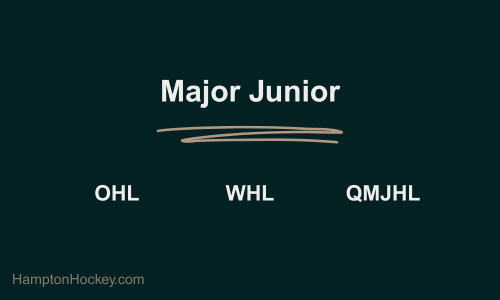
First you have Major Junior hockey in Canada. The word major is added because it’s one level higher than Jr A in Canada.Major junior hockey encompasses the three CHL (Canadian Hockey League) leagues in the OHL, WHL, and the QMJHL.
Second, you have Junior Hockey as a whole which gets broken down further into a few main tiers which are Tiers 1-3 and Independent.
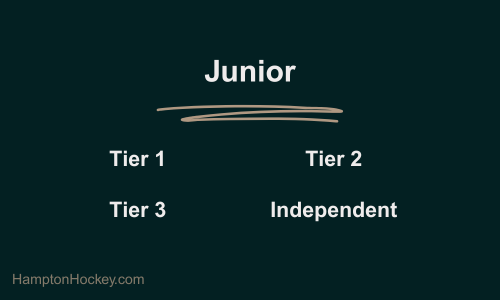
The only Tier I junior level in the US today is the USHL.
In Canada, Junior “A” leagues are considered Tier 1 level as well. They’re generally just referred to as Jr A though.
Tier 2 junior hockey includes the NAHL, NCDC, and the EHL in the US. These are all Junior A leagues. The Tier 2 equivalent in terms of level here is quite on par to the top Jr B tiers in Canada.
Moving down to the next level of Tier 3 in the US, this includes NA3HL, EHLP, USPHL Premier, and USPHL Elite.
When you read Tier 3 above, you may (or may not) think lower level. But the level of hockey in tiers is quite wide in terms of the overall level of individual players here.
Numerous players from some of these Tier 3 leagues later advance to NCAA programs at the D1 and D3 levels and we’ve helped many of them do so. It’s helpful to keep this in mind.
We’ll spend the next two Chapters going over the levels/tiers in the US and Canada in more detail…
What are the main levels of junior hockey in the United States?
In the prior chapter, we briefly touched on the various tiers.
Here in Chapter 3, we’ll expand on the tiers and the leagues within those levels.
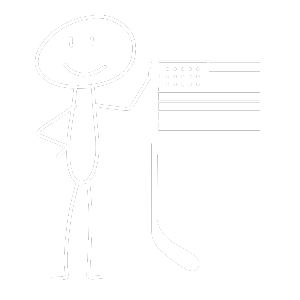
To play here, you’ll need to be at an elite level of hockey.
Outside of major junior hockey, the USHL is widely considered to be one of the top junior leagues in the world in terms of caliber and the sheer number of NCAA Commitments the league produces year after year.
We touched on this in the previous chapter, but these junior A leagues are all considered Tier II in the United States.
It’s a little bit more attainable to play here than Tier 1 if you’re a strong player for your age group, but it’s still extremely competitive in terms of supply vs demand.
Many rostered players are scouted.
The leagues above are all considered Tier 3 level. There’s a number of quality players and teams in many of these leagues.
As a player if you haven’t played junior yet and that’s a goal of yours to get your foot in the door, it’s much more realistic of an aim to try to play here as a next step.
We’ve helped many players from various playing backgrounds play in all three of the tiers above.
What are all the levels of junior hockey across Canada?
Compared to the US, there’s a few more levels and types of leagues.
We’ll break them all down in this Chapter for you.
These three major junior leagues are the top 3 junior leagues in North America. A solid number of eventual NHL players have come from these three leagues alone.
For decades, the NCAA considered major junior players as professionals across the board. This made them immediately ineligible for NCAA play at the D1 level.
In 2025, the rules changed and players from the CHL can now maintain NCAA eligibility as long as they aren’t paid more than standard expenses from their team.
The majority of players that finish major junior that aim to keep playing go on to play USports on scholarship or professionally in the ECHL, AHL, NHL, and Europe. The NCAA is now an additional path (doesn’t apply to the NCAA D3 level) for some major junior players.
Junior A hockey in Canada is a solid level of hockey. Many of these leagues have players that go on to play at higher levels beyond junior
As you can see from our list above, there’s quite a number of Junior B leagues throughout Canada.
In terms of level, the best way to broadly describe the level of Junior B hockey in Canada is by comparing it to Tier II or III juniors in the US.
At this level, you have a combination of quality Canadian players, a few US players, and then a couple players who’ve maybe played major junior or junior A and they’re finishing out their junior playing career here.
The level of hockey at the Junior C tier in Canada varies quite a ton from one league to the next.
Even from one team to the next within the same league.
Some junior C clubs run a more tight ship in terms of how the club operates while other organizations may not have the same resources.
The only independent junior league in Canada currently is the GMHL.
The reason it’s independent is because it operates outside of Hockey Canada’s rules in terms of player recruitment, bringing over imports, etc.
What makes a junior hockey league legitimate?
The answer to this varies a bit depending on who you talk to, but it’s an important question every player/parent should be asking.
Here in Chapter 5, we’ll help you understand the best way to determine this per whichever league you’re evaluating.
If you’re this far into our guide, it's likely you have interest in learning more about junior hockey for one reason or another.
Maybe you (or your player) has shown interest in playing juniors, you've been contacted by a team, or something similar.
If so, that’s great…
How do you know though if a junior hockey league is a good fit or not based on your situation?
Having helped players navigate this same path over many years, we have a few initial questions you can ask to help you decide if a particular league is or isn’t the right fit.
The first question is:
The aim here is to try to be as unbiased and honest with yourself as you can be.
It’s great to have ambition to play at the highest level you can (that’s expected)…but if your current level of play and the level at a particular junior level are too far apart today…it doesn’t make a ton of sense to pursue that specific level as the best next step.
Many players stepping into their 1st year of junior may start out at one level and move to the next level based on how they play.
Going in with this perspective not only makes it more likely you’ll find a place to play…but also more potential opportunity to develop and play well there.
If you’re not sure where you may (or may not) fit, you can always ask someone what leagues could be most realistic for you or your player…whether it’s asking another player or coach with direct junior experience or if not…asking an advisor.
The next two questions to ask are around junior player advancement.
With so many junior leagues across the US and Canada, it’s hard to know where each stands in terms of player advancement.
Unless a junior hockey league says how many players they advance to the next level, it’s hard to know a lot of times.
You can also ask this same question on an individual team level...
Reason why this may be helpful to look at when evaluating a junior team is that it helps you get a sense for it it aligns with your goals if the aim is to keep playing.
For example, you may have two junior teams in the exact same league.
Junior team 1 may have an experienced coach/staff who are big advocates for helping players get exposure to potentially play at the next level (ex: NCAA)
Junior team 2 is in the same league, but for one reason or another, less priority is placed on advancing players.
Just because a junior team hasn’t produced many players to the next level yet doesn't mean it can't be a great place to play. Maybe the team is only in it's second season or something else...it’s just one factor to consider in the overall equation and can be helpful to look at.
As a player at the junior level, you’ll still often need to be your own biggest advocate to will your way up to the next level. Having a team that can support you in that effort certainly helps. Our team has strong internal data on the majority of junior leagues and teams in terms of their success rates for advancing players.
A last good question to ask is:
This questions important to ask so you know if it’ll align financially
The cost per season to play junior hockey can range widely from zero to around $10,000-15,000 usd per season on the high end.
Primary reason for the wide range is due to there being so many different junior leagues, all with different organizational structures.
Leagues such as the USHL and other top junior leagues may cost nothing to players to play there. We’ve even had many players at the Junior A and B level in Canada who played cost free and were given a small additional stipend to help cover gas expenses, etc.
Many junior hockey leagues in North America cost money to play there though as there’s a lot for teams to pay for ranging from the cost of ice all season, team equipment, staff salaries, travel, accommodations on the road (hotels, buses), and so on.
For leagues that are “pay to play”, the costs generally go towards all of the above and another big expense which is player housing in-season.
By asking (or at minimum thinking about) the few questions above, you should be able to get a little better sense of alignment for a particular junior league to know if it’s a good league or not for you.
We’ve made it to the final chapter (stick tap).
How do I/we decide on the best path for me to take?
Here in this closing Chapter, we’ll wrap close out this guide which should help you in deciding.
Based on all the information we’ve gone over in the prior chapters alongside the few questions we covered in the last chapter (on What Makes A Junior Hockey League Legit?), you should now have a bit clearer lens into potential paths for you.
You might be thinking…okay, maybe these leagues are a potential aim OR I’d really like to play in this league, but I haven’t played juniors yet so maybe these other few leagues could be a good starting place to get my foot in the door.
If you’re thinking any of these, awesome...
It’s important to remember that every player (and their families) situation is completely unique….so what makes sense league wise for one player may or may not be the right fit for another.
That’s important to keep in mind.
We hope that our teams guide and decades of insights above has helped provide you with a little bit further understanding on the junior hockey landscape as a whole.
If you’re a player who’s ambitious to play at the next level, keep working hard on and off the ice to develop your skill/game. Keep your head up, have fun in the process, and focus on the daily effort you put in based on what’s fully in your control. This along with the right resources can make all the difference in playing at the next level up.
If you (or your player) is reading this and you’re in a position where you want to play junior but aren’t sure how to garner interest or maybe you have interest but want to play at a higher next level, don’t hesitate to reach out to us with a message.